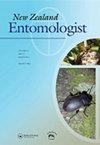A preliminary survey of altitudinal variation in two ground wētā species, Hemiandrus maculifrons (Walker) and Hemiandrus pallitarsis (Walker) (Orthoptera: Anostostomatidae)
IF 0.4
4区 农林科学
Q4 ENTOMOLOGY
引用次数: 4
Abstract
Species’ ranges along altitudinal clines are probably influenced by their ability to adapt to a range of abiotic factors. Physical adaptations in response to lower temperatures at higher altitudes often include changes in body size. We investigated the distribution and potential change in body size with altitude of two species of ground wētā, Hemiandrus maculifrons and Hemiandrus pallitarsis in the Moehau Ecological Area on the Coromandel Peninsula, North Island, New Zealand. Over eight nights of searching, 17 adult H. maculifrons and 28 adult H. pallitarsis were found. Hemiandrus maculifrons was the smaller of the two species and was found at higher altitudes compared with H. pallitarsis (91–577 m and 27–207 m, respectively). No ground wētā were caught in baited and unbaited live-catch pitfall traps (40 set at 211–242 m above sea level; 40 at 620–626 m above sea level). Despite what appeared to be a tendency for the size of male H. maculifrons to increase with altitude, we found no evidence of intraspecific variation in body size with altitude although sample sizes were small. Nevertheless, these two species of ground wētā appear well suited to further investigations into aspects associated with factors that influence body size, distributional range shifts and climate change.两个地面wētā种maculifrons和pallitarsis(直翅目:Anostostomatidae)海拔变化的初步调查
物种沿海拔线的分布范围可能受到它们适应一系列非生物因素的能力的影响。在高海拔地区,为了适应较低的温度,身体上的适应通常包括体型的变化。研究了新西兰北岛科罗曼德尔半岛Moehau生态区两种地面昆虫wētā (maculifrons和pallitarsis)的分布及其体型随海拔的变化趋势。经过8个晚上的搜寻,共发现17只黄斑夜蛾成虫和28只白斑夜蛾成虫。maculifrons的体型较小,分布在海拔较高的地区(分别为91 ~ 577 m和27 ~ 207 m)。没有地面wētā被带饵和未带饵的活鱼陷阱捕获(40个设置在海拔211-242米;在海拔620-626米的地方)。尽管雄性斑孔猴的体型有随海拔增加而增加的趋势,但我们没有发现种内体型随海拔变化的证据,尽管样本量很小。然而,这两种地面wētā似乎很适合进一步研究影响体型、分布范围变化和气候变化的因素。
本文章由计算机程序翻译,如有差异,请以英文原文为准。
求助全文
约1分钟内获得全文
求助全文
来源期刊

New Zealand Entomologist
ENTOMOLOGY-
CiteScore
0.70
自引率
33.30%
发文量
3
审稿时长
>12 weeks
期刊介绍:
The invertebrate diversity of New Zealand is of great interest worldwide because of its geographic isolation and geological history. The New Zealand Entomologist plays an important role in disseminating information on field-based, experimental, and theoretical research.
The New Zealand Entomologist publishes original research papers, review papers and short communications. We welcome submissions in all aspects of science regarding insects and arthropods in a New Zealand or Australasian setting. The journal’s subject matter encompasses taxonomy, phylogenetics, biogeography, biological control and pest management, conservation, ecology and natural history.
The journal is the official publication of the Entomological Society of New Zealand. Papers published or submitted elsewhere for publication will not be considered, but publication of an abstract or summary elsewhere (e.g. conference proceedings) does not preclude full publication in the New Zealand Entomologist. Accepted papers become copyright of the Entomological Society of New Zealand. The journal is published in English, but we also welcome publication of abstracts in Maori.
 求助内容:
求助内容: 应助结果提醒方式:
应助结果提醒方式:


